native american
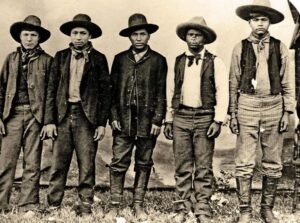 The Rufus Buck Gang was a multiracial group of African American and Native American outlaws, notorious for a series of murders, robberies, and assaults. They were a brutal bunch, and they considered anyone fair game…men, women, and children. Headed up by Rufus Buck, the gang also consisted of Lucky Davis, Maoma July, Lewis Davis, and Sam Sampson. The men had no scruples and no respect for life. Their criminal activities took place in the Indian Territory of the Arkansas-Oklahoma area from July 30, 1895, through August 4, 1896.
The Rufus Buck Gang was a multiracial group of African American and Native American outlaws, notorious for a series of murders, robberies, and assaults. They were a brutal bunch, and they considered anyone fair game…men, women, and children. Headed up by Rufus Buck, the gang also consisted of Lucky Davis, Maoma July, Lewis Davis, and Sam Sampson. The men had no scruples and no respect for life. Their criminal activities took place in the Indian Territory of the Arkansas-Oklahoma area from July 30, 1895, through August 4, 1896.
Before they started their crime spree, the gang began while staying in Okmulgee, Oklahoma, by building up a small stockpile of weapons. Then, on 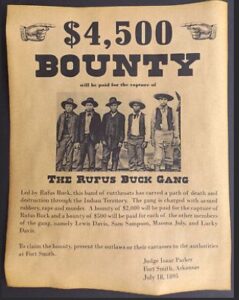 July 30, 1895, they killed Deputy US Marshal John Garrett. With the lawman out of the way, they began holding up various stores and ranches in the Fort Smith area over the next two weeks. Then, the brutality began. During one robbery, a salesman named Callahan, after being robbed, was offered a chance to escape…if he could outrun the gang. Callahan was an elderly man, and they thought an easy mark, but he successfully escaped, which angered the men, so the gang killed his assistant in frustration. At least two female victims who were raped by the gang died of their injuries.
July 30, 1895, they killed Deputy US Marshal John Garrett. With the lawman out of the way, they began holding up various stores and ranches in the Fort Smith area over the next two weeks. Then, the brutality began. During one robbery, a salesman named Callahan, after being robbed, was offered a chance to escape…if he could outrun the gang. Callahan was an elderly man, and they thought an easy mark, but he successfully escaped, which angered the men, so the gang killed his assistant in frustration. At least two female victims who were raped by the gang died of their injuries.
In all, the gang, Killed Deputy US Marshal John Garrett. Then on July 31, 1895, they came across a white man and his daughter in a wagon, the gang held the man at gunpoint and took the girl. They killed a black boy and beat Ben Callahan until they mistakenly believed he was dead, then took Callahan’s boots, money, and saddle. They robbed the country stores of West and J Norrberg at Orket, Oklahoma. They murdered two white women and a 14-year-old girl. Then, on August 4th, they raped a Mrs Hassen near Sapulpa, Oklahoma. Hassen and two of three other female victims of the gang…a Miss Ayres and an Indian girl 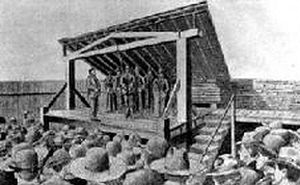 near Sapulpa, all died; and a fourth victim, Mrs Wilson recovered from her injuries. Continuing attacks on both local settlers and Creek indiscriminately, the gang was finally captured outside Muskogee by a combined force of lawmen and Indian police of the Creek Light Horse, led by Marshal S Morton Rutherford, on August 10. While the Creek Light Horse forces wanted to hold the gang for trial, the men were brought before “Hanging” Judge Isaac Parker. The judge twice sentenced them to death, the first sentence not being carried out pending an ultimately unsuccessful appeal to the Supreme Court. They were hanged on July 1, 1896 at 1pm at Fort Smith.
near Sapulpa, all died; and a fourth victim, Mrs Wilson recovered from her injuries. Continuing attacks on both local settlers and Creek indiscriminately, the gang was finally captured outside Muskogee by a combined force of lawmen and Indian police of the Creek Light Horse, led by Marshal S Morton Rutherford, on August 10. While the Creek Light Horse forces wanted to hold the gang for trial, the men were brought before “Hanging” Judge Isaac Parker. The judge twice sentenced them to death, the first sentence not being carried out pending an ultimately unsuccessful appeal to the Supreme Court. They were hanged on July 1, 1896 at 1pm at Fort Smith.

 I was talking with my sister-in-law, Brenda Schulenberg yesterday, and she mentioned that our niece, Machelle Moore had only had 6 times in her life that Thanksgiving had fallen on her birthday. Having a late November birthday, one might expect to have a Thanksgiving birthday more often, but because her birthday was very late in the month, that is just not the case.
I was talking with my sister-in-law, Brenda Schulenberg yesterday, and she mentioned that our niece, Machelle Moore had only had 6 times in her life that Thanksgiving had fallen on her birthday. Having a late November birthday, one might expect to have a Thanksgiving birthday more often, but because her birthday was very late in the month, that is just not the case.
Thinking back on Machelle’s life, I recall that she was born three days after Thanksgiving in 1976. Bob and I had taken our girls to visit his aunt and uncle in Kennebec, South Dakota, and the weather had turned bad. I don’t recall if we had to spend an extra day or not, but I do remember that Machelle’s mom, Debbie Cook went into labor and after about 36 hours of labor, had to have a Caesarean Section for Machelle to be delivered. It was a bit scary, but in the end, we went home to meet our new little 
 niece. She was born 6 months after my Amy and 18 months after my Corrie, so the girls were always good friends.
niece. She was born 6 months after my Amy and 18 months after my Corrie, so the girls were always good friends.
Machelle has changed so much over the years. Not only has she grown tall like her dad, LJ Cook, but she has grown sweeter every year. Machelle has a kind heart. I don’t know anyone who doesn’t love her very much. She is a wife to her best friend, Steve Moore. They love each other so much, and are very well suited to each other. They both love to go rock hunting, and often come back with great pieces of obsidian that Steve turns into Native American tools that are beautiful…and the real shock is that Steve isn’t Native American. It’s a cool passion that Machelle and her husband share.
Machelle is also mom to two boys, Weston and Easton, who are almost grown men now. Weston has graduated from high school, and Easton is in high school. As the boys have grown, Machelle feels a little bit sad, because  she knows that soon they will be out on their own and she will be an empty nester, like so many others who have gone before her into that new identity. For some it is difficult and for others it is easy…or at least not as hard as for others. I think Machelle will do fine, because she has a wonderful marriage. She and Steve share so many interests, including camping, rock hunting, and the company of good friends and family. Yes, I know that Machelle and Steve will have a long wonderful life together, and before she knows it, daughters-in-law and grandchildren. I’m sure she is not in a huge hurry to get there, but it is a nice dream of the future. Today is Machelle’s birthday. Happy birthday Machelle!! Have a great day!! We love you!!
she knows that soon they will be out on their own and she will be an empty nester, like so many others who have gone before her into that new identity. For some it is difficult and for others it is easy…or at least not as hard as for others. I think Machelle will do fine, because she has a wonderful marriage. She and Steve share so many interests, including camping, rock hunting, and the company of good friends and family. Yes, I know that Machelle and Steve will have a long wonderful life together, and before she knows it, daughters-in-law and grandchildren. I’m sure she is not in a huge hurry to get there, but it is a nice dream of the future. Today is Machelle’s birthday. Happy birthday Machelle!! Have a great day!! We love you!!
 As the pioneers headed west, there were various disputes over ownership of the lands they were settling into. The Native American people did not think that they should have to surrender their lands to the White Man, but it seemed that they had no choice. Still, there were some Native Americans who refused to be pushed around by the government. On August 17, 1862, violence erupted in Minnesota as desperate Dakota Indians attacked white settlements along the Minnesota River. This was a fight that the Dakota Indians would eventually lose. They were no match for the US military, and six weeks later, it was over.
As the pioneers headed west, there were various disputes over ownership of the lands they were settling into. The Native American people did not think that they should have to surrender their lands to the White Man, but it seemed that they had no choice. Still, there were some Native Americans who refused to be pushed around by the government. On August 17, 1862, violence erupted in Minnesota as desperate Dakota Indians attacked white settlements along the Minnesota River. This was a fight that the Dakota Indians would eventually lose. They were no match for the US military, and six weeks later, it was over.
The Dakota Indians were often referred to as the Sioux, which I did not know was a derogatory name derived from part of a French word meaning “little snake.” It almost makes it seem like they were talking badly about them to their face, but so they couldn’t understand it. The government treated the Dakota poorly, and the Dakota saw their hunting lands dwindling 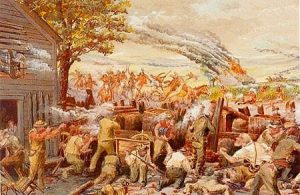 down, and apparently the provisions that the government promised to supply, rarely arrived. And now, to top it off, a wave of white settlers surrounded them too. To make matters worse, the summer of 1862 had been a harsh one, and cutworms had destroyed much of the crops. The Dakota were starving.
down, and apparently the provisions that the government promised to supply, rarely arrived. And now, to top it off, a wave of white settlers surrounded them too. To make matters worse, the summer of 1862 had been a harsh one, and cutworms had destroyed much of the crops. The Dakota were starving.
On August 17, the situation exploded when four young Dakota warriors returning from an unsuccessful hunt, stopped to steal some eggs from a white settlement. The were caught and they picked a fight with the hen’s owner. The encounter turned tragic when the Dakotas killed five members of the family. Now, the Dakota knew that they would be attacked. Dakota leaders, knew that war was at hand, so they seized the initiative. Led by Taoyateduta, also known as Little Crow, the Dakota attacked local agencies and the settlement of New 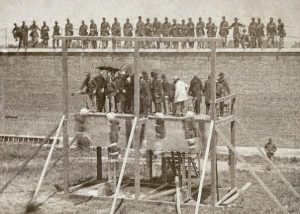 Ulm. Over 500 white settlers lost their lives along with about 150 Dakota warriors.
Ulm. Over 500 white settlers lost their lives along with about 150 Dakota warriors.
President Abraham Lincoln dispatched General John Pope, fresh from his defeat at the Second Battle of Bull Run, Virginia. Pope was to organize the Military Department of the Northwest. Some of the Dakota immediately fled Minnesota for North Dakota, but more than 2,000 were rounded up and over 300 warriors were sentenced to death. President Lincoln commuted most of their sentences, but on December 26, 1862, 38 Dakota men were executed at Mankato, Minnesota. It was the largest mass execution in American history, and it was all because they were starving, and had no hope of living through that year.

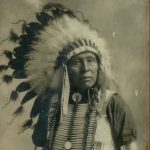 When Colorado Governor John Evans was looking to win a seat in the United States Senate, he made a bold, but unwise decision to attempt to remove all Native American activity in eastern Colorado Territory. On June 24, 1864, he warned that all peaceful Indians in the region must report to the Sand Creek reservation or risk being attacked. It was truly a halfhearted offer of sanctuary, with an ulterior motive. Evans then made one bad decision after another, when he issued a second proclamation that invited white settlers to indiscriminately “kill and destroy all…hostile Indians.” At the same time, Evans began creating a temporary 100-day militia force to wage war on the Indians. He placed the new regiment under the command of Colonel John Chivington, another ambitious man who hoped to gain high political office by fighting Indians.
When Colorado Governor John Evans was looking to win a seat in the United States Senate, he made a bold, but unwise decision to attempt to remove all Native American activity in eastern Colorado Territory. On June 24, 1864, he warned that all peaceful Indians in the region must report to the Sand Creek reservation or risk being attacked. It was truly a halfhearted offer of sanctuary, with an ulterior motive. Evans then made one bad decision after another, when he issued a second proclamation that invited white settlers to indiscriminately “kill and destroy all…hostile Indians.” At the same time, Evans began creating a temporary 100-day militia force to wage war on the Indians. He placed the new regiment under the command of Colonel John Chivington, another ambitious man who hoped to gain high political office by fighting Indians.
The Sioux, Cheyenne, and Arapahoe Indians of eastern Colorado had no idea of the political maneuverings of the White Man. Although some bands had violently resisted white settlers in years past, by the autumn of 1864 many Indians were becoming more receptive to Cheyenne Chief Black Kettle’s argument that they must make peace. Black Kettle had recently returned from a visit to Washington, DC, where President Abraham Lincoln had given him a huge American flag of which Black Kettle was very proud. He had seen the vast numbers of the white people and their powerful machines. The Indians, Black Kettle argued, must make peace or be crushed.
Word of Governor Evans’ June 24 offer of sanctuary was not well received by many of the Indians, most of whom still distrusted the White Man and were unwilling to give up the fight. Only Black Kettle and a few of the  lesser chiefs took Evans up on his offer of amnesty. Evans and Chivington were reluctant to see hostilities further abate before they had won a glorious victory, so they weren’t overjoyed that Black Kettle and his people accepted the offer. Nevertheless, they grudgingly promised Black Kettle that his people would be safe, if they came to Fort Lyon in eastern Colorado. In November 1864, the Indians reported to the fort as requested. Major Edward Wynkoop, the commanding federal officer, told Black Kettle to settle his band about 40 miles away on Sand Creek, where he promised they would be safe.
lesser chiefs took Evans up on his offer of amnesty. Evans and Chivington were reluctant to see hostilities further abate before they had won a glorious victory, so they weren’t overjoyed that Black Kettle and his people accepted the offer. Nevertheless, they grudgingly promised Black Kettle that his people would be safe, if they came to Fort Lyon in eastern Colorado. In November 1864, the Indians reported to the fort as requested. Major Edward Wynkoop, the commanding federal officer, told Black Kettle to settle his band about 40 miles away on Sand Creek, where he promised they would be safe.
Unfortunately, Wynkoop could not control John Chivington, and John Chivington was not inclined to honor the promise of safety. By November, the 100-day enlistment of the soldiers in his Colorado militia was nearly up, and Chivington hadn’t killed any of the Indians. With his political stock falling rapidly, and he seemed almost insane in his desire to kill Indians. “I long to be wading in gore!” he is said to have proclaimed at a dinner party. In his demented state, Chivington apparently decided that it did not matter whether he killed peaceful or hostile Indians. In his mind, Black Kettle’s village on Sand Creek became a legitimate and easy target, and he assumed that no one would ever know the difference.
Chivington led 700 men, many of them drunk, in a daybreak raid on Black Kettle’s peaceful village on November 29, 1864. Most of the Cheyenne warriors were away hunting. In the horrific hours that followed, Chivington and his men brutally slaughtered 105 women and children and killed 28 men. The soldiers scalped and mutilated the corpses, carrying body parts back to display in Denver as trophies. Somehow, Black Kettle and a number of other Cheyenne managed to escape. Chivington’s treachery would not go unnoticed as he had supposed, and in the following months, the nation learned of the horror of Sand Creek. Many Americans were 
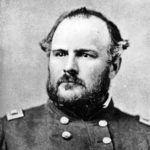 horrified and disgusted. Chivington and his soldiers had left the military and were beyond reach of a court martial. Still, Chivington’s horrific acts killed any chance of realizing his political ambitions, and he spent the rest of his inconsequential life wandering the West. Evans also paid a great price for the scandal. He was forced to resign as governor and his hopes of holding political office were dashed. Evans went on to a successful and lucrative career building and operating Colorado railroads, however. I suppose time can make people forget wrongs done, whether they should be forgotten or not.
horrified and disgusted. Chivington and his soldiers had left the military and were beyond reach of a court martial. Still, Chivington’s horrific acts killed any chance of realizing his political ambitions, and he spent the rest of his inconsequential life wandering the West. Evans also paid a great price for the scandal. He was forced to resign as governor and his hopes of holding political office were dashed. Evans went on to a successful and lucrative career building and operating Colorado railroads, however. I suppose time can make people forget wrongs done, whether they should be forgotten or not.

